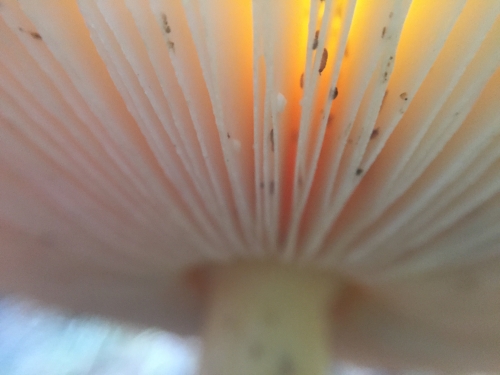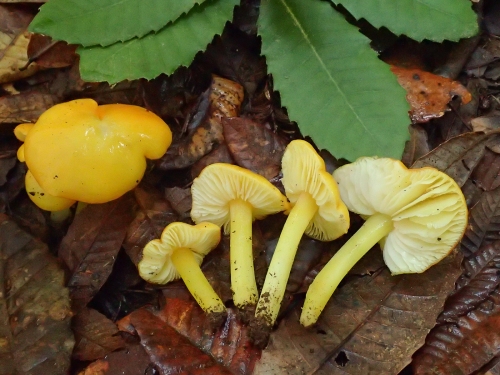Trent Pearce joined us February 25th, 2016 at the Lake Merritt Rotary Nature Center to introduce us to the Kingdom of Fungi, focusing on mushrooms. As with many of our lectures, I didn’t really know how little I knew.

First of all, Trent asked what are Fungi? We can say they are not plants… they are in fact closer relatives to humans than plants are. They are consumers of other things, they don’t produce their own food. They also have chitin in their cell walls. Chitin is a sugar that is also found in insect exoskeletons, and is what provides structural support to the organism.
The Fungi kingdom includes yeasts, chytrids (the fungus causing problems for amphibians), molds, lichens, and mushrooms. Fungi split off from animals on the order of 650-900 million years ago. Our common unicellular ancestor has carried on as choanoflagellates (of which there are about 125 species). For a long time Fungi were considered by science as part of the Plant Kingdom. The inventor of our current scientific classification of organisms Carl Linnaeus in ~1735 only had plants and animals separated out as kingdoms. It wasn’t until 1959, when Robert Whitaker separated them out as their own things.
What we know of as mushrooms are only part of the whole organism. They are the fruiting bodies of the larger organization that lies mostly out of site.
The continuous organization is made out of strands called hyphae, which collectively grow into mycelium, which once or twice a year, put up fruiting bodies in order to reproduce.
The fruiting bodies thrust up out of the ground and when they are fully grown release spores from their gills. The spores spread out and mix with the spores from other fruiting bodies. There isn’t just a male female dynamic going on, but something considerably more complicated with some species having up to 20,000 sexual combinations. When the spores meet and match they grow into hyphae and combine, and if all works out, grow into mycelium, and the cycle continues.
The fruiting body grows by being inflated with water pressure, provided by the below ground mycelium network. With the right circumstances you can put a mushroom onto a wet paper towel and have it expand.
These fungus have extracellular digestion. Generally this means that enzymes and acids are excreted from the ends of mycelium, to produce simple sugars, amino acids and fatty acids, but a whole host of bio products gets created which are what makes fungus sometimes a positive thing (thing alcohol from yeast, and antibiotics) but also deadly (thing of all the poisonous mushrooms out there). All of these things are purposed to help protect the fungi in one fashion or another.
There are three general ecological strategies that mushroom fall under: decomposers, parasites, and mutualists.
Decomposers decompose everything from leaf litter to wood. Wood specialists fall into one of 2 types: white rot which digest lignin and leave cellulose, and brown rot which does the opposite eating the cellulose but leaving the lignin. Often these are the mushrooms that look like little shelves on rotting logs, and they sometimes specialize in the wood that they consume.
Other mushrooms are parasites — it might be wood rot fungus that evolved to have a go at live wood. There are both generalist and specialists. Honey mushrooms are generalists, but a type of Ganoderma focuses on Bay Laurel and can often be found at the base of these tress. There are also mushroom parasites that attack insects and turn them into zombies to get the insect into a favorable position for spore dispersal (for example: Ophiocordyceps unilateralis. Some of these mushrooms actually have medicinal uses.
Mutualism is the other broad category of life strategy mushrooms employ. The best example of this is ectomycorrhizal fungi which grow around tree roots. The mushrooms provide nutrients (breaking things down into nutrients) and water to the tree (the mushrooms serve to extend the surface area of the root system). In exchange, the tree provides sugars. Many of these mushrooms have specific hosts… chanterelles live along with hardwoods like oaks. Amonita like pine. The presence of these fungus can have an impact on how well trees germinate.
There are also a couple reproductive strategies that different fungus employ: ascomycetes and basidiomycetes. Ascomycetes is employed by yeast, leaf molds, cup fungus and others. The organism produces strands called asci which are fluid filled and contain the spores. These are pressurized until they explode shooting the spores out (up to 30cm — which may not seem a lot, but these are tiny things). Examples of mushrooms that do this are earth tongue, scarlet cup, elven saddle, and orange peel fungus.
Basidiomycetes grow typically 4 spores on things called Basidia. The spores here are ejected through a process employing water tension… where water collecting on two different surfaces meet, and the release of water tension and the change of center of mass discharges the spores. It’s been estimated that spores are shot off with an acceleration of 10,000g’s! (Money, N.P. 1998. More g’s than the Space Shuttle: ballistospore discharge. Mycologia 90:547-558.)
With a quick guide to anatomy, Trent went on through a bunch of major groups of mushroom, with some first notions of how to identify things. The annulus (ring) is something that covers the gills while the mushroom is coming out of the ground, the remnants of it can sometimes be seen. The stipe the stem, and the volva is an egg like structure that some mushrooms grow out of (mainly Amanita). Any problem with the table below is probably my note taking error, not Trent’s mistake.
| Type | Cap | Gills | Annulus | Spore | Stipe | Vulva | Notes |
|---|---|---|---|---|---|---|---|
| Agaricus | Dull colored cap | Pink brown gills | Persistent | Dark brown | Button/portabella mushrooms amongst others | ||
| Amanita | Can be colorful | White gills | Can be persistent or absent | Have a Volva | Many of these are poisonous | ||
| Boletes | Dense fleshy | Pore layer not gills | Absent | Variable | Grow from soil | ||
| Suillus | Often slimy | Pore layer | Annulus present, but often degraded | Variable | Grow from soil | ||
| Cantharellus | Atypical trumpet shapes | Blunt many forked gills | Absent | Reduced | Grow from the soil, resistent to rot | ||
| Russula | White cream | Attached white gills | Yellow | Brittle. Flesh breaks cleanly like chalk. Has elongated cellular structre. | |||
| Lactarius | Has concentric rings | Absent | White to yellow | “Bleed” latex. An oak associate. Brittle. | |||
| Hygrophoraceae (Waxy Caps) | Orange and Green slimy/waxy cap | Absent | White | Grow in the duff near redwoods and sometimes oak. | |||
| Polypores | Shelf like growth | Pores | Absent | No stem | Parasites and wood rooters. The are hard, made out of the material they consume, and most are perrenial. |
The great thing about mycology, Trent offered, is that amateurs are still doing the bulk of the discovery, and that there is still much to know about Mushrooms.
If all this peaks your interest, Trent advises a few things:
- Get a book. He gave a few possibilities: Mushrooms Demystified, All that Rain Promises and More, Field Guide to Mushrooms, and later this year Mushrooms of the Redwood Coast (the author is a local amateur mycologist)
- Get out and find mushrooms, measure, document, and try and identify
- Share your observations (iNaturalist or MushroomObserver.org). There are great online communities who can help.
There are also plenty of local mushroom groups, and online resources like the Santa Cruz Mycoflora Project.
Learning to ID is an important thing especially if you are looking to eat mushrooms. Immigrants are often victims of mushroom poisoning because the mushrooms they grew up with can resemble deadly ones here, but even knowledgable people can make mistakes, and if you are looking for a cautionary tale, KQED has one for you here.
Trent in the winter time can often be found leading mushroom walks in the East Bay hills, and year round leading other fun naturalist events. See more at EBRPD’s event calendar.
